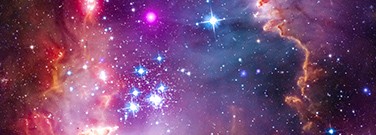Dust, Gas, and Collisions: The Building Blocks of Planets

By Mike Howie
Imagine this: a young star glides through space encircled by a disk of gas and dust. Millions of years later, the disk is gone and in its place are planets of varying size and composition. How did this happen?
Scientists disagree, and many theories have been proposed. According to the ancient Greeks, planets formed from the chaos that filled the universe. Not very precise. Famed French philosopher, mathematician, and scientist René Descartes posited that planets sat in concentric bands and stars were the center of a swirling vortex, which also left room for questions.
In the 18th century we started getting somewhere: Swedish mystic Emanual Swedenborg proposed that, basically, debris circling a star eventually clumps up and forms planets. Today, that’s known as the nebular hypothesis, and it remains central to our understanding of planet formation.
But that’s not to say that the debate has been settled. Other theories have since been proposed and scientists are still exploring the process that transforms space dust into hulking planets. It would be hyperbolic to say that there are as many ideas about planetary formation as there are planets in the known universe, but there sure are a lot of them.
A Slow Build
The theory du jour is known as pebble accretion. The idea is that, when small rocks pass through the gas around large rocks in a star’s orbit, they slow down and heat up, eventually landing on the larger rock. In this way a rock gets bigger and bigger, growing into a planet in a few million years. Think of a snowball rolling down a snowy hill or a sticky ball across a dirty carpet and you get the picture.
As with other scientific theories, pebble accretion was born from another idea. In the 20th century, many scientists believed that planets were created when increasingly large rocks collided with each other. But there’s a few problems that theory doesn’t account for: First, it would take too long. The disk of gas and dust that surrounds a star would have disappeared before a planet the size of Jupiter or Saturn could form. Second, the collisions would be unlikely given the neat orbits of known planets. And third, even if the collisions did happen, the rocks would probably just break apart and drift away, not stick together.
Pebble accretion differs — and holds up — because it depends on smaller rocks and factors in gas. It’s much more likely that a large object will encounter many small objects than it is for two large objects to collide. And the gas is key: it helps trap smaller objects until the rock is big enough to generate gravity, which attracts even more building materials, some of which can form an atmosphere.
Lingering Questions
The theory isn’t perfect, though. It requires many other factors to be perfect: there must be rocks big enough for smaller ones to land on, enough matter in the disk to create an entire planet, ample time for the planet to grow, and the right temperature to bring everything together. Even some of the most vocal proponents of pebble accretion acknowledge that it might not deliver all the answers.
It’s also unclear if pebble accretion can form small, rocky planets like Earth and Mars or just giants like Jupiter and Saturn, which could have blocked the flow of pebbles to planets forming closer to the center of the solar system.
Nevertheless, pebble accretion is a strong theory, one that gets us closer to fully understanding the mysteries of planet formation.
Discussion Questions
- What are some other theories of planetary formation? What are their pros and cons?
- Where does the gas and dust in a star disk come from?
Vocabulary
- Accretion
- Concentric
- Hyperbolic
- Nebula